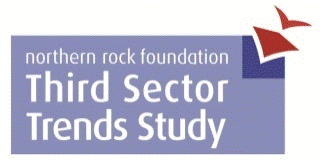 The Northern Rock Foundation Third Sector Trends Study has published its latest report. This working paper by Professors Tony Chapman and Fred Robinson presents headline findings from the most recent round of the TSO1000 survey which has been running since 2010. The findings show that the sector is more robust than the sector itself believes to be the case. That stated, it is recognised that on a day to day basis, organisations do have to ‘struggle against the odds’ to keep going: especially so in the case of middle sized TSOs.
The Northern Rock Foundation Third Sector Trends Study has published its latest report. This working paper by Professors Tony Chapman and Fred Robinson presents headline findings from the most recent round of the TSO1000 survey which has been running since 2010. The findings show that the sector is more robust than the sector itself believes to be the case. That stated, it is recognised that on a day to day basis, organisations do have to ‘struggle against the odds’ to keep going: especially so in the case of middle sized TSOs.
The future is uncertain. It is clear that the financial situation for the sector as a whole is likely to be put under considerable pressure over the next two years as pressure on public spending continues. Furthermore, in North East England and Cumbria, it is apparent that the volume of grant funding to the Third Sector will reduce to a significant extent due to the closure of the Northern Rock Foundation’s grant funding programmes in December 2014.
These pressures will not exert themselves upon all TSOs in the same way. The smallest TSOs may be the most likely to experience income stability, but they are by no means invulnerable – they need grant funding and in-kind support to keep going. They form the majority of organisations in the Third Sector and make a massive contribution to the maintenance of social wellbeing in communities of interest or place. The work of such organisations and groups may not result in the kinds of ‘transformational changes’ that government at national and local level often hope for. But they hold things together – purposefully to neglect them would be a perilous strategy.
Medium sized TSOs are often under the greatest financial pressure and tend to be the most vulnerable to change in the funding environment. Often they are not in a position successfully to bid to undertake public sector contracts individually or in partnership – and often they do not want to. Those medium sized TSOs which deliver front-line services may find it increasingly hard to fund their work – which is worrying because they may provide essential support to beneficiaries. This may be happening when the demand on their services is rising – which may partly be due to the reduction or closure of equivalent or complementary services by local authorities or other public sector bodies.
Larger TSOs are amongst the most resilient in the Third Sector. This is because they have a stronger asset base and work across larger areas. Larger TSOs tend to prepare well for future challenges and opportunities because they have the resources to do so, while medium sized organisations can struggle in this respect – further threatening their stability. But larger TSOs are not immune to pressure. As public sector organisations seek better value for money from the contracts they let, the pressure to do more for less grows. Similarly, larger TSOs can sometimes be locked out from funding opportunities if preference is given to local grass roots organisations, or when it is simply assumed that they are better resourced than is actually the case.
While the future looks uncertain, it is clear that most TSOs are adept at survival. Few organisations in the Third Sector feel that they are on a ‘knife edge’. On the contrary, there is a strong sense that many organisations are adapting quite well to the ‘new normal’. Optimism about the future is relatively high, and indeed it has become more pronounced since we started studying the sector in 2012.
The full report is available here.
